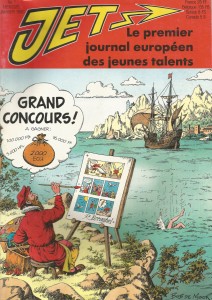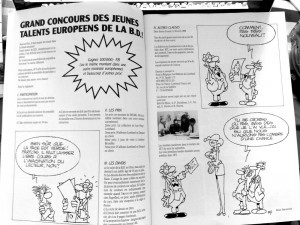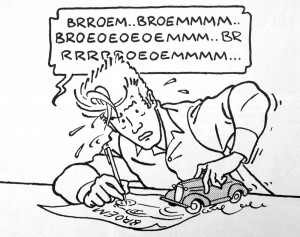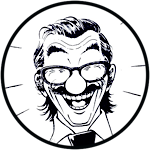
In January 1990 Lombard launched a brand new comic talent seeking magazine for the french speaking and dutch speaking market: Jet. The plan was to release 10 issues every year. The issues were sold separately for more or less € 3,40 or for € 28,20 if you chose a yearly subscription. Distributed in France, Belgium, Switzerland, Canada and The Netherlands, the magazine would however fold after 11 issues in a market where comic magazines were selling less and less.
The magazine’s editorial staff consisted of Rob Harren (general director/editor), Jean-Luc Vernal (editor in chief), A.-P. Duchateau (scenario writer/literary editor), Bob De Moor (artistic director/comic author) and Georges Permin. The aim was to launch new talents and show them to the public because as Rob Harren would prophetically write in his editorial: “… the options for young comic authors have become close to inexistent”. Little would he know that Jet would suffer exactly the same faith 13 months later.
Positive as always Bob De Moor says that the stories in that (and the following) issue promise a brilliant future for the participating comic authors. For the occasion the magazine launched a € 2.500 contest. While the winner would take that nice amount home, other prizes for the 4 runner ups would include the Deluxe edition of Hergé as published by Lombard, 50 and 25 Dargaud/Lombard albums of your choice and a one day visit at Lombard.
The cover Bob De Moor created shows Pieter Breughel having a go at winning the € 2.500 contest. The subject of his comic: the fall of Icarus (with Icarus thumbing down right into the sea just in front of him). In Breughel’s comic version he lets Icarus alive though (in Greek mythology, Icarus fell into the sea and drowned). It’s a comic after all.
Note that the drawing itself (the front rock part & plants, the sea with the boat, the falling Icarus in the sea, the city in the background) refers to Breughel’s own painting “Landscape with the Fall of Icarus“. Technical examinations in 1996 showed that it could as well have been a good early copy by an unknown artist of Bruegel’s original, but that’s just a discussion between ‘specialists’. The lines are very sketchy for this cover and serve the purpose as De Moor probably wanted to look the drawing dated as if it were an actual old ink sketch.

Included in this issue are also 3 cartoons by Peter de Smet showing a mustached gentlemen in a suit judging the entries for said contest. Yeps, indeed, de Smet made cartoons of Bob De Moor. As you can see on the left, they are quite funny. For the non-french speaking readers, the first cartoon has a text balloon saying “Of course this is a blanco page, you need to give some freedom to the reader’s imagination!”, the second says “What do you mean with ‘not innovative’ enough?”, and the last one says “Belive me or not, but the moment I saw her I knew we didn’t stand a chance.”

The biggest revelation for the clear line fans will be the drawings by Teun Berserik (son of the well known Dutch graphic artist Hermanus Berserik) who also drew his version of what you would think is probably Barelli. But it’s actually a self portrait by Berserik. The story he published in Jet, “Le chat”/”De Kat”, is completely in the style of Hergé/De Moor (reminding also that of Eric Heuvel). It would remain one of his few published stories in said style as he is a lot more active as illustrator. More recently he released “Vincent van Gogh – De vroege jaren” which got quite some positive feedback for its aquarel style.
